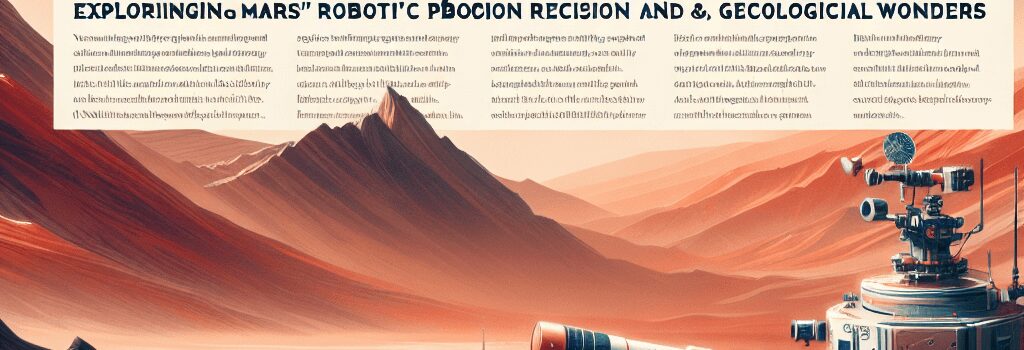Tuesday Telescope: Exploring Mars’ Robotic Precision and Geological Wonders

In an era when pseudoscience and sensationalism often cloud our view of the cosmos, it’s refreshing to focus on the real, intricate engineering that brings us our daily dose of celestial wonder. Today’s feature revisits a familiar topic with a deeper dive into the technical marvels behind Mars exploration.
Rediscovering the Daily Telescope
The legacy of the Daily Telescope posts—once a daily celebration of astronomical achievement—has evolved into a weekly exploration of groundbreaking space technology. While the daily cadence eventually tip-toed over from joy to drudgery, the reassessment into a weekly feature preserves the essence of discovery while allowing us time to delve into technical insights and expert commentary.
A Closer Look at Mars’ WATSON Camera
Today’s image, beamed from Mars, showcases one of the Perseverance rover’s star components: the WATSON camera. Standing for Wide Angle Topographic Sensor for Operations and eNgineering, this camera is not only a testament to NASA’s penchant for playful acronyms but also a marvel of modern engineering. Affixed to the end of the rover’s versatile robotic arm, WATSON is strategically positioned on the SHERLOC instrument—Scanning Habitable Environments with Raman and Luminescence for Organics and Chemicals—to capture granular details of Martian terrain.
Technical specifications of the WATSON camera include high-resolution imaging capabilities that allow it to capture minute textures on rocks and soils. Its variable focal settings and advanced sensor arrays facilitate imaging under the extreme lighting conditions of Mars. The integration of the camera with the robotic arm ensures that it can maneuver into positions that optimize shot quality, even when examining surfaces that are only a few millimeters across.
Engineering Marvels: The Rover’s Robotic Arm
Beyond the camera itself, the robotic arm of the Perseverance rover represents a pinnacle in mechanical engineering. Designed to operate in the harsh Martian environment, the arm is built with precision actuators, redundant control systems, and robust thermal management to withstand temperature extremes. Detailed telemetry data from this system have allowed engineers on Earth to fine-tune its performance continually, ensuring that every motion translates into scientifically valuable imaging.
- High-Precision Actuators: These components enable micro-movements necessary for the WATSON camera to focus on intricate geologic features.
- Advanced Sensor Suite: The integration with SHERLOC provides a multifaceted approach to surface analysis, incorporating Raman spectroscopy and luminescence measurements.
- Thermal Stabilization: Essential for maintaining operational integrity under Mars’ drastic temperature fluctuations.
Deep Dive: Technical Innovations and Future Implications
Recent updates and continuous analysis reveal that the Perseverance rover’s systems are pushing the envelope in extraterrestrial robotics. Experts have highlighted the significance of high-fidelity images captured by instruments like WATSON, noting that these allow planetary geologists to study sedimentary layers, erosional features, and potential biosignatures with unprecedented clarity.
Moreover, innovations in sensor integration and autonomous operation pave the way for future missions. The data from the robotic arm’s maneuvers not only inform us of Mars’ past water activity but also contribute to the engineering playbook for upcoming ventures, including sample return missions and even human exploration scenarios. As the rover enters its fifth year on Mars, these improvements underscore a shift towards more autonomous and resilient space robotics.
Expert Perspectives and Ongoing Developments
Leading engineers and planetary scientists have weighed in on these technological strides. Dr. Alicia Monroe, a robotics specialist at the Jet Propulsion Laboratory, remarked, “The precision we see in WATSON’s imaging is a direct result of iterative engineering and real-time refinements made possible through robust telemetry. This sets a new standard for remote sensing in space.”
Similarly, geologist Dr. Ravi Patel emphasized that the detailed images allow researchers to perform micro-scale analyses that were once relegated to controlled Earth laboratories. “The integration of high-resolution cameras and advanced spectroscopy instruments gives us a window into Mars’ geological history,” he noted.
Conclusion: Mars as a Beacon of Innovation
While we face complex challenges on Earth, the technological achievements on Mars provide a glimpse into human ingenuity and resilience. The images, like the close-up of a Martian rock captured by WATSON, remind us that our exploration of the cosmos is not only about overcoming terrestrial inequities but also about peering into the mysteries of the universe. The meticulous documentation of Mars’ geology heralds new chapters in space exploration—chapters powered by cutting-edge robotics and innovative engineering.
If you’re inspired by these feats of technology and wish to contribute, do not hesitate to reach out with your insights and even your photography. The universe awaits, and so does the next breakthrough in interplanetary exploration.